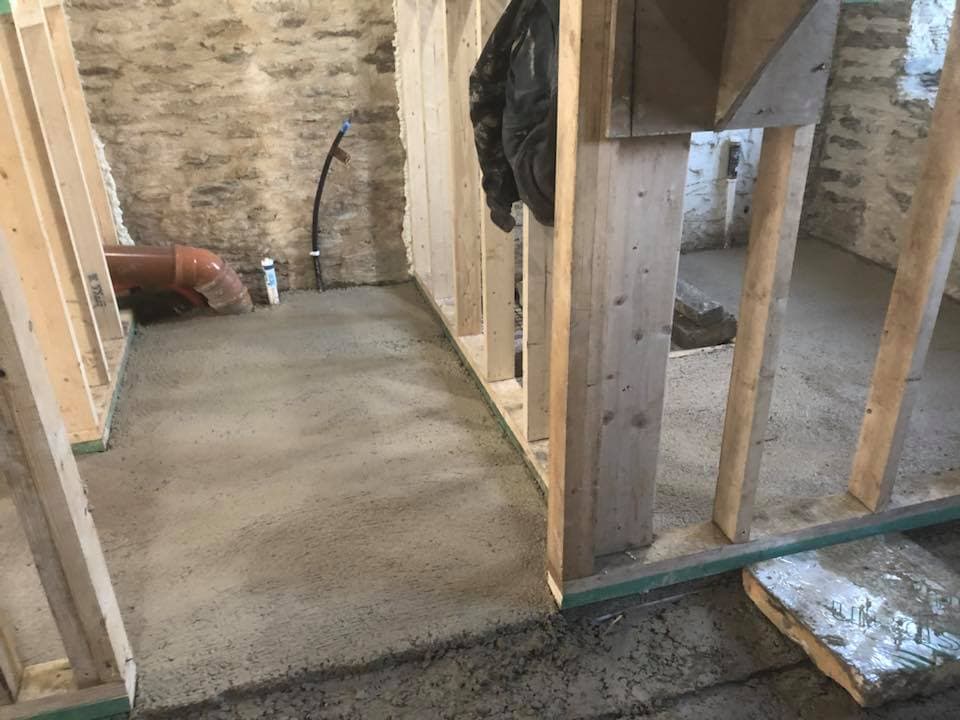
Limecrete floors may well be the right option for your old building or renovation, but before you go ahead there’s a few things you need to know, says sustainable building experts.
Old buildings allow moisture to be absorbed by the fabric of the building and evaporate away naturally. This is what we call a ‘breathable’ fabric.
Breathability can be important when it comes to floors in old buildings, as they often consist of stone floors laid directly on the earth. In its original situation any moisture below the floor could rise to the floor surface to evaporate away with no detriment.
If we then install a concrete insulated floor with a dampproof membrane (DPM), any moisture below the floor will continue to rise and, as the floor is now impermeable, may get pushed to the walls where it could appear as damp spots. It is this that gives rise to the idea of a breathable floor and where limecrete comes to the rescue for old building owners.
Limecrete
Limecrete is a mix of natural hydraulic lime and sharp sand or glass fibers are mixed in to give a more durable surface.
Once the limecrete has been installed, any breathable floor finishing material can be used to finish.
Thermal Efficiency
The low thermal conductivity of earth floors mean that they provide good thermal mass. They are capable of absorbing heat and releasing it when the internal temperature drops. When the earth is reasonably dry, the ground under the building will maintain a fairly stable temperature of around 10°C year round. But that is not enough to meet modern standards of thermal efficiency and potential heat loss, so some form of insulation and, perhaps ironically, a moisture barrier, is needed. Standard insulation materials are not breathable, so cannot be used, neither can a traditional DPM.
Recycled Foam Glass as an Insulator
The default option is recycled foam glass – small foamed glass beads used as the base to limecrete (rather than hardcore) – that provides both the insulation and the moisture barrier, although a breathable moisture barrier can also be used.
There is another reason why recycled foam glass may be used. Achieving true breathability is always tricky and lime is a more tricky material to work with than cement. It needs mixing in a different way, and needs different laying and curing methods.
Laying limecrete in cold or wet weather conditions can be problematic and the usual hardcore base will also be a problem. Hardcore allows capillary action that could draw up ground moisture. As a breathable floor cannot have a traditional DPM, that moisture could penetrate the limecrete and cause damp problems. There are not many non-capillary substrate materials available, which is why foamed glass beads have become the default option.
Any Floor Finishes Can Be Used
Any breathable floor finishing material will be fine. If stone, slate or tiles are used then the grout gap needs to be a little wider than usual and the adhesive must also be breathable. Wood is the most favourable and presents no problems.
Limecrete in All Old Homes
Limecrete ability to deal with naturally occurring moisture. It has nothing to do with air moving in and out of the house. A modern house, built to modern standards, will be able to deal with moisture, without the trouble and expense of breathable construction.
Geocell foam glass is now widely used under concrete construction in new builds, with a separate LABC approved systems.
When it comes to old properties with stone floors laid directly on the earth, there is an argument that these are breathable floors and if you are replacing them, then there is a need for limecrete. There are two problems with this argument:
- The stone making up the floor may or may not be breathable. Slate, for instance, is not a breathable material and was commonly used as flooring. Any ‘breathing’ (i.e. moisture dispersal) can only be through the joints between the slate slabs. The implication is that if we laid a concrete floor but left sufficient gaps around the edges, that too would be breathable.
- If we have a breathable floor, by implication at least, we will also need breathable wall.
The problem facing people converting old buildings is how to bring them to modern standards of comfort and meet the ever-growing demands for CO2 reduction while retaining the character of the original building.
A limecrete floor, laid on foamed glass, is seen as one way of helping with this problem. It prevents damp penetration, provides insulation, maintains breath ability and provides a solid, durable floor, in character with the original building. But it is an expensive option using materials that are tricky to work with, and not necessary as often as might be imagined.